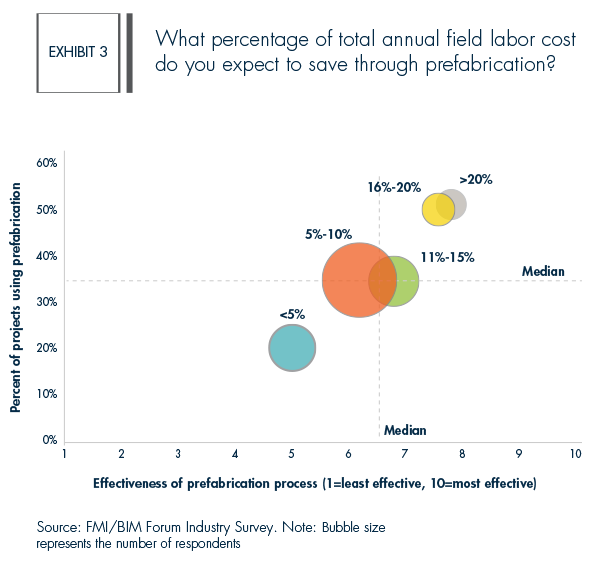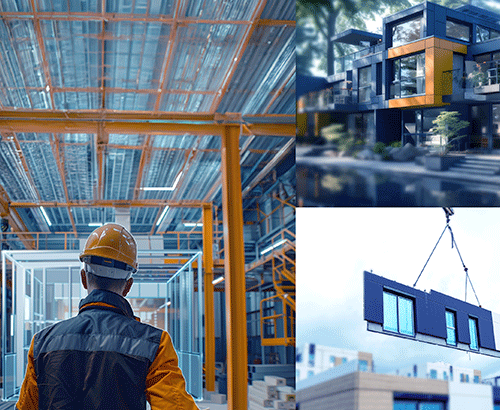Prefabrication: The Changing Face of Engineering and Construction

For decades, industry stakeholders have lamented the inefficiencies and lack of productivity in the engineering and construction (E&C) industry.
Today, dozens of innovative companies are reshaping and transforming traditional E&C business models by learning and adapting new manufacturing and prefabrication techniques to work smarter, faster and safer. This “silent movement” is happening in pockets across the country, in different market sectors and across a range of project types and sizes. And while this may not be a sweeping transformational disruption across the entire E&C space, there is no doubt that transformation is happening.
Given that prefabrication has been around for decades, how is it influencing today’s U.S. engineering and construction environment and what—if anything—has changed since we last surveyed the industry in 2013? In this article, we provide fresh insights from FMI’s prefabrication industry study (conducted in collaboration with the BIM Forum) and offer several high-level recommendations on how to start thinking about innovation and prefabrication to prepare your company for the future.
A New Kind of Renaissance
Directly translated as “rebirth,” the word “renaissance” refers specifically to the rebirth of learning that began in Italy in the 14th century and ended in Northern Europe in the mid-17th century. It was during this time that the concept of the “Renaissance Man” was born: a man with many talents or areas of knowledge.[1] Such individuals included Da Vinci and Michelangelo, and their roles covered strategic advisor, builder, planner, designer, engineer, artist, inventor and physician—each of whom is considered a distinct profession today. These multitalented individuals were also commonly known as polymaths or “master builders.”
Several centuries later, during “The Age of Synergy” (1867-1914),[2] rapid industrial development blended with new technologies to advance engineering and construction techniques. As a result, both disciplines became far more complex, forcing professionals to specialize in specific areas within their chosen disciplines. Consequently, the master builder’s environment splintered into many branches of specialization.
Fast forward to today: The construction industry is back on track since the Great Recession, and total construction employment has rebounded to just over 6.5 million[3] workers (still a far cry from its peak of 8 million workers in 2006). However, despite being almost 20% below its 2006 peak, the industry is struggling to find qualified labor. Compounding these statistics, baby boomers are reaching retirement age at a rate of 10,000 per day, while fewer, less experienced (millennial) workers are moving into the E&C industry.
Simultaneously, the evolution of design and construction functions has taken a leap forward during the past decade, with the transition from electronic drafting to high-resolution digital modeling (also known as Building Information Modeling or BIM). Ubiquitous digital connectivity, cloud computing, 3-D printing and big data are just a few of the evolving drivers that are responsible for the current melding of engineering, architecture, fabrication, construction and other related disciplines.
Today, all of these factors are setting the stage for revolutionary change and have helped prefabrication and modular construction make a comeback at a time when low cost, resource efficiency and tight schedules are priorities. In essence, we are witnessing the undoing of 100 years of expansive industry fragmentation where contractors and designers alike are taking on the role of master builders again.
Geoffrey Golden, president at Golden Construction, stated, “We always saw prefabrication as a three-step process: Create, Innovate and Revolutionize. Create so it functionally works. Innovate so it holistically works. Revolutionize to improve the industry. It took us three years of hard work through our “creating stage,” before we started truly affecting the whole project. We currently reside in our “innovate stage” focused on making prefabrication affect the bottom line. We continue to see more and more success on our projects and look forward to transitioning into a “revolutionize stage,” impacting the industry and ultimately fulfilling our purpose to “Build People, Revolutionize the Industry.”
Our recent industry research[4] confirms that change is happening: Almost 80% of the survey respondents stated that today’s prefabrication environment is different compared to just three years ago (Exhibit 1).

Prefabrication Today: A Snapshot
In fall 2016, FMI and the BIM Forum surveyed more than 150 contractors (both GC/CM and specialty contractors), and FMI conducted over 30 follow-up interviews with study participants to delve deeper into the survey findings. Following are five key research findings, which will be discussed in more detail in the upcoming study report:[5]
- The prefabrication environment has changed. Almost three-quarters (74%) of study participants indicated utilizing prefabrication as a means of construction. Of those using prefabrication, almost 80% indicated that today’s prefabrication environment is different than that of three years ago.
Aaron Thompson, director of operations at Corbins Electric, stated, “When you’re talking about large commercial projects, I don’t think prefabrication is going to be an option in the future. We’re seeing more and more written into the contract that off-site fabrication is mandatory, and the owners are not giving us a large laydown yard on-site. And if I’m already seeing that now, after the past three-year push, I can only imagine what’s going to happen in the next five to 10 years.”
- Most contractors struggle to make prefabrication effective. One of the most staggering statistics in this study is that almost 90% of all survey respondents perceive their prefabrication process as ineffective or in need of improvement. Only 14% think their prefabrication process is effective (Exhibit 2).

Steve Foote, vice president and operations manager at Greiner Electric, stated, “I’ve been doing prefab for almost 27 years. I’ve seen a lot of things that worked and were worth doing, but that didn’t work as well as originally desired. I refer to prefab as a “process,” in that you have to constantly evaluate it and be willing to experiment and try different things. You stay after it. You HAVE to listen to the field as they are living it, work out the problems they are communicating to you, and eventually you will hit on it just right. There are very few things we’ve ever done that were perfect right out of the gate, but you keep after it and will get there. Prefab definitely takes a vision and an unwavering commitment. The fundamental concept of prefab is solid: When done right, it will save your field forces a lot of time, and I firmly believe there will not be enough field guys in the very near future—if not already. A contractor has to ask itself the obvious question: ‘How are we going to accomplish the same results without all of the field manpower?’ There is a steep learning curve. It is huge. If you fail at prefab, it’s expensive. You have to have that mindset of, ‘Ok, that was all right, but if we had done it like this or used these parts, or done it this way instead, it would have worked out a lot better.’”
- Practice makes perfect. Making prefabrication truly effective requires a steep learning curve. Our research findings show that contractors using prefabrication on more than 50% of their projects not only are more effective, but also expect to save over 16% of total annual field labor cost. The majority of survey respondents lie in the midrange of our effectiveness scale (around 6) and only expect to save 5-10% of total annual field labor cost (Exhibit 3).

- Timing is critical. Only a fifth (21%) of study participants plan for prefabricated assemblies during the design stage. Three-quarters of respondents plan for prefabricated assemblies during preconstruction (56%) or construction (15%), which might explain some of the challenges related to effectiveness mentioned earlier.
Another important aspect is the fact that prefabrication requires a completely different “control” philosophy. Guy Skillett, director of construction at Rhumbix, explained, “Construction companies are accustomed to planning, sequencing and executing their work using traditional scheduling methodologies. When you move to prefabrication, processes for production planning and control change substantially. Prefabrication relies on managing just-in-time delivery and inventory, and with traditional construction planning methods, you’re pushing your planning out into the future. The problem with that is it’s making huge assumptions about where the project, your materials and everything else will be in the future. Unless you’re paying very close attention to your schedule, updating it appropriately and monitoring at the right level of detail, these forward-looking forecasts may not necessarily be reliable.”
- Project inefficiencies and improved technologies drive prefabrication. Study participants listed the following top-three factors in driving the demand for prefabrication: 1) The need for productivity improvement and lean construction, 2) improved technologies and 3) competitive advantage (in winning bids and increasing profits).
Innovating With Prefabrication: It’s More Than Just Technology
Prefabrication is not new, yet our findings show that the industry is still struggling to adapt this manufacturing technique at a broad level. With the rapid emergence of innovative technologies, such as augmented reality, 3-D scanning and printing, XD-BIM, drones, etc., it is easy to get caught up in all the technology buzz and forget about what it really takes to innovate and change. From our work with clients and conversations with study participants on the topic of prefabrication, one thing has become very apparent: The biggest barrier to change and transformation as it relates to prefabrication is not technology, it’s culture. Getting people to embrace new ways of thinking and doing work differently is one of the most challenging (and most critical!) aspects of successful change. The following recommendations touch on some key areas that can make or break a successful prefabrication strategy:
- Prefabrication starts at the top. As with all important strategic initiatives, the “business of prefabrication” starts at the top, with committed leaders who communicate a clear strategy and strong message around what it is the company is trying to achieve. Successful companies typically select a champion at the executive level to head up the prefabrication initiative and ensure that everyone is aligned with the company (prefab) vision and strategy.
- Wanted: A “Why can’t we?” culture. One of the common themes across all the interviews was the challenge of overcoming set ways and old habits. Introducing an innovative concept like prefabrication takes people who are curious, tenacious, willing to learn new things and willing to take risks. It is also particularly important to develop a culture in which employees are not afraid to make mistakes and where everyone is open to learning from each other’s mistakes. As one interviewee stated, “It’s important for the field guys to know that they can communicate the issues they’re running into and that there’s a willingness to hear and evaluate that feedback. Ultimately, they’re the ones who have to install everything.”
- It’s an all-or-nothing deal. In our work with contractors, we often come across situations whereby a project manager or superintendent might be experimenting with prefab on a project-by-project basis. Prefabrication, however, is not something you can just dabble in and expect to see big returns from. It is an entirely different business philosophy that must be a fundamental part of the corporate strategy. Otherwise, it just ends up being a very expensive mistake. As one study participant confirmed, “You have to be committed to it, because you fail more at prefab than you’re going to succeed. It takes a long time to get somewhat good at it.”
- Leverage young talent. Many millennials grew up with parents, teachers and counselors who were their best friends and role models. As such, they are excellent team players and care about the company’s success—not just their own jobs (see FMI’s Industry Survey, “Millennials in Construction: Learning to Engage a New Workforce”). The timing for this kind of mindset is perfect: BIM and prefabrication require a high degree of collaboration within and among project teams. Having these young people focused on a common purpose, effective processes, excellent communication and solid relationships will help transform your company over time.
- Do your homework. Before jumping into the world of prefabrication, learn the industry best practices and study some of these questions and topics:
a) What types of customers or work require prefabrication?
- How fast will demand grow for this type of work?
- Does this fit into your company strategy and vision?
b) What is different about using prefabrication? And what are the implications for your organization?
- For example: What are best practices for inventory controls, tracking work progress, packaging, shipping and delivery, etc.?
c) How do you implement prefabricated assemblies effectively in the field?
- What new skill sets and competencies are needed? How do you prepare your workforce to adapt to all of these changes? What are the cultural implications?
Looking Ahead
In the wake of the Great Recession, companies of all sizes have started to redefine themselves by looking at new and innovative ways to deliver projects and explore new “spheres” of the built environment. While some have made more progress than others, the industry as a whole still has a long way to go to increase productivity and overcome project inefficiencies.
However, there is a distinct undertone of emergence here that presents growing concerns and opportunities for the successful company of the future. There are new questions and problems to be tackled and solved, including:
- What will the construction/manufacturing/design firm of the future look like?
- What role will prefabrication play, and what happens if our company doesn’t begin the learning curve now?
- Where will we find the talented people to work in the emerging world of integrated technologies and project teams?
The new master builders will need to solve these problems, and today’s “design, engineering and construction industry” organizations will likely be positioned very differently 10 to 15 years from now.
FMI will continue to study and analyze these evolutionary trends and provide insights into this critical business area on an ongoing basis.
[1] http://oxforddictionaries.com
[2] Vaclav Smill called the period 1867–1914 “The Age of Synergy,” during which most of the great innovations were developed. Unlike the First Industrial Revolution, the inventions and innovations were science-based.
[3] Bureau of Labor Statistics. Employment statistics for May 2016.
[4] FMI and the BIM Forum partnered in fall 2016 to conduct an industry study on prefabrication.
[5] The Prefabrication Industry Report is scheduled to be released in January 2017.

.jpg)

